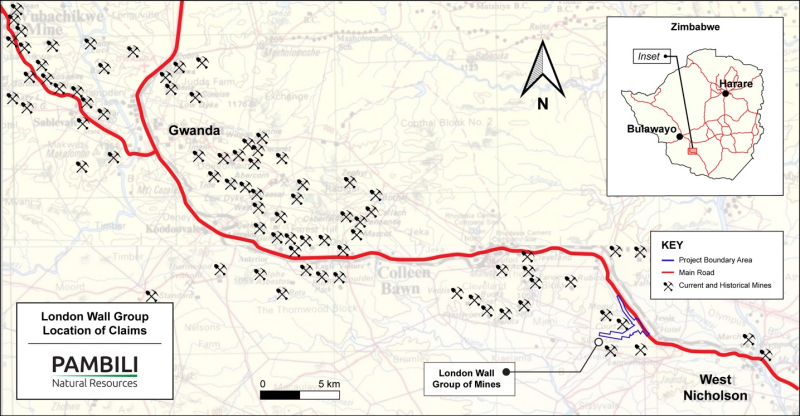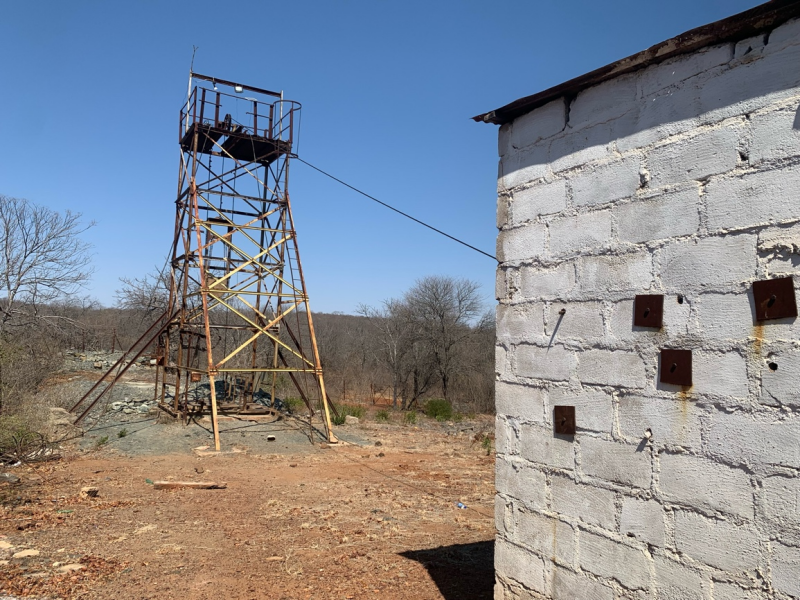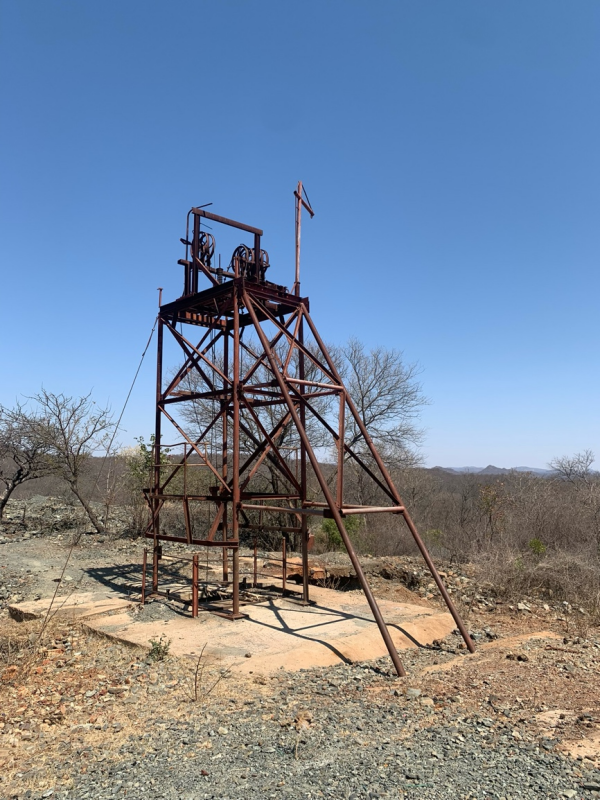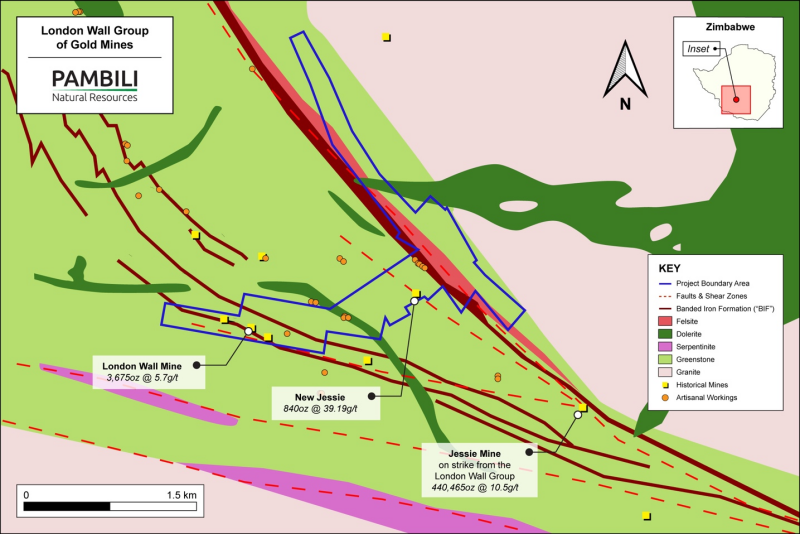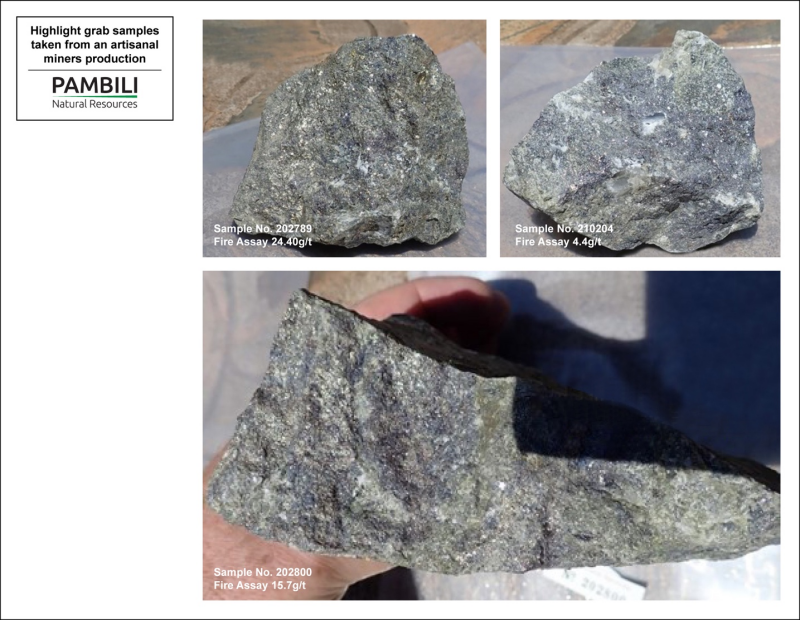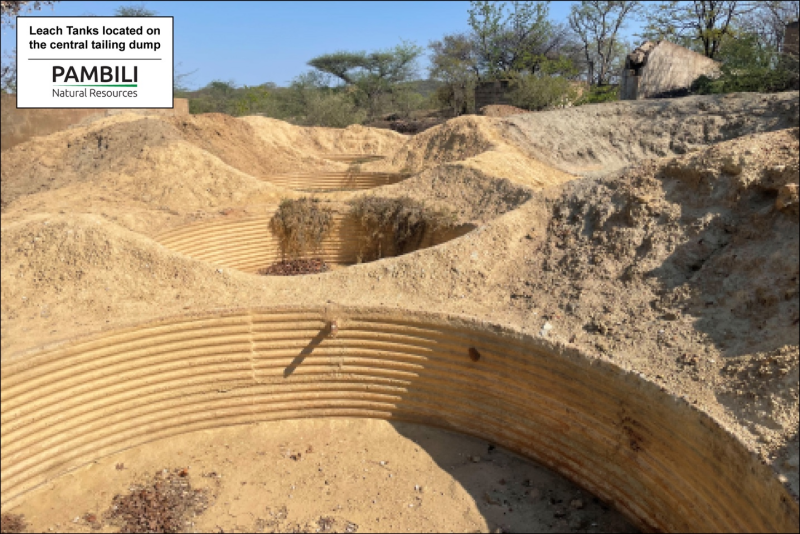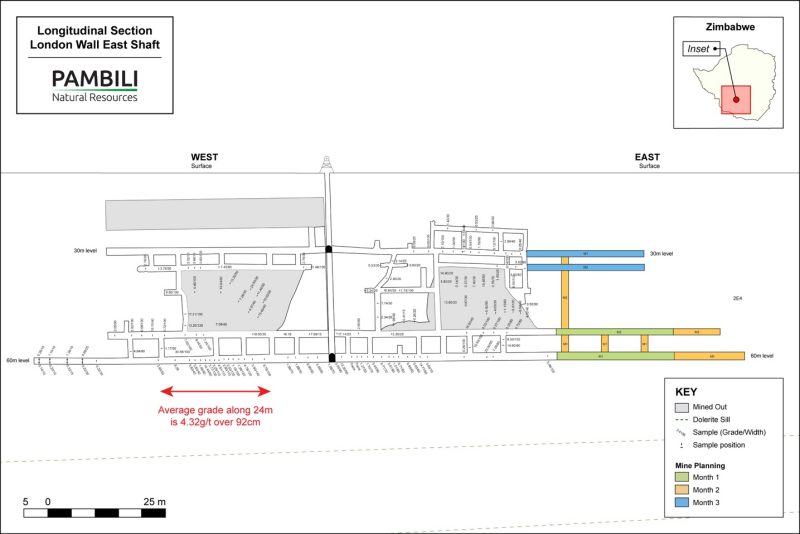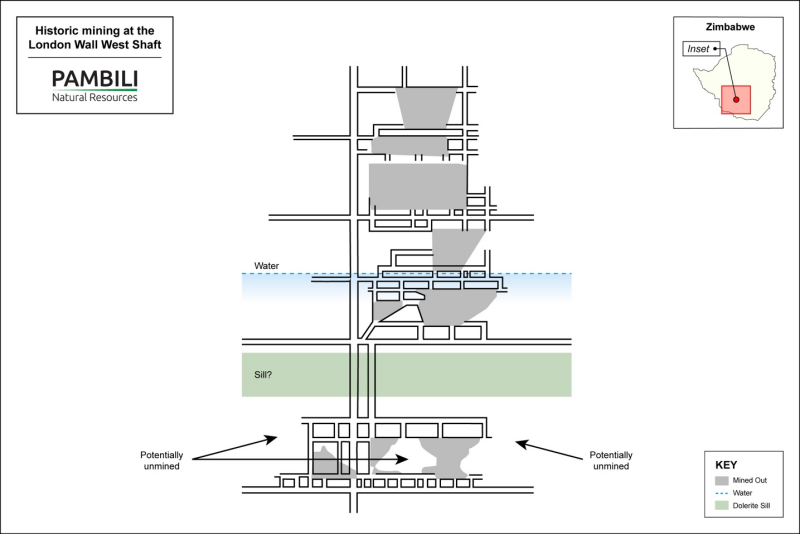 |
|||||||||
 |
 |
 |
|||||||
CALGARY, Canada – TheNewswire – Nov. 20, 2024 – Pambili Natural Resources Corporation (“Pambili” or the “Company”) (TSX-V: PNN) is pleased to announce that it has signed a 12-month option agreement (the “Option”) with Long Strike Investments (Private) Limited (“Long Strike”) to acquire the London Wall group of gold mines and claims located in the Gwanda district of Matabeleland, Zimbabwe.
Under the terms of the Option, Pambili has the right to acquire 21 gold claims (the “Claims”), which cover 173 hectares (“ha”) and include the previously producing London Wall and New Jessie mines (the “Mines”). In addition, Long Strike has applied for contiguous extensions to the Claims, totalling an additional 547.8 ha. Once granted, these extensions are included in the Option.
Highlights
-
A 12-month option to acquire the Mines, with the ability to extend the Option for a further 12 months as required (the “Term”)
-
The Mines include two historic producing mines: London Wall and New Jessie
-
The Claims are located on three interpreted major regional gold-bearing geological structures
-
A regional dolerite sill has acted as a natural barrier, potentially protecting significant, previously unrecognized gold mineralization underneath that sill
-
-
Pambili will conduct extensive due diligence and exploration of the Claims during the Term
-
Should Pambili exercise the Option, the total acquisition cost of the Mines and Claims will be US$1 million, to be satisfied through a combination of cash and Pambili shares. The subsequent Share Purchase Agreement will be subject to the approval of the Toronto Venture Exchange, and any Pambili shares issued to complete the potential acquisition will be subject to a statutory four-month-and-one-day hold.
-
A “Right to Mine” Agreement, signed as part of the Option, allows Pambili to commence gold production at London Wall, initially by processing tailings and sands, and then moving into underground mining
-
The London Wall and New Jessie mines were both mined as recently as two years ago
-
Pambili expects to bring at least one of these mines back into production within the Term
-
Grab samples of recently mined ore from the London Wall West Shaft, taken by Long Strike, returned values of 4.4 grams per tonne (g/t), 15.7 g/t and 24.4 g/t (samples analyzed at a local non-accredited laboratory)
-
Pambili will retain 95% of any gross income generated from the Claims and Mines during the Term.
-
Jon Harris, Chief Executive Officer of Pambili Natural Resources, commented:
“This opportunity is a major step forward for Pambili. We are excited to establish a second mining hub with the potential to deliver on Pambili’s target of becoming a significant gold producer in Zimbabwe. The Option to acquire the London Wall group of mines provides Pambili with a potentially significant source of near-term cash flow, and also provides time to further evaluate the Claims and Mines ahead of a possible exercise of the Option.
Although the historical data has yet to be independently verified, the reported figures corroborate previous production records, and we are excited to have this opportunity to confirm the potential of the the project.
The immediate goal will be to rehabilitate the static leach tanks at London Wall and commence re-processing the gold tailings to generate revenue. A simultaneous evaluation of the underground operations should define the scope and related cost of bringing the East Shaft back into production. Given that the shaft was last operated less than two years ago, we believe it should still be in good condition.
A site near the East Shaft will be prepared for the installation of a 20-tonne-per-day crushing and milling plant that has already been purchased by Long Strike.”
The London Wall group of mines
The Claims are located in the Gwanda District of the Matabeleland South Province of Zimbabwe, approximately 160 km to the southeast of Bulawayo on the main A6 road to South Africa. These Claims include the previously producing London Wall and New Jessie mines, which the Company believes to have significant potential to be explored, evaluated and reopened by using more modern methods and technologies.
Figure 1: Regional map highlighting the location of the Claims and the London Wall group of claims and surrounding mines.
The London Wall and New Jessie mines have recorded combined historical production of more than 4,500 ounces of gold at an average recovered grade of 11.9 g/t, as shown in Table 1. Recent miners have also reported significant silver production alongside gold.
|
Mine |
Ounces |
Recovered |
Recorded Date |
|
London Wall |
3,675 |
5.70 |
1990* |
|
New Jessie |
840 |
39.19 |
1940** |
|
Total Ounces |
4,515 |
11.93 |
Table 1: Recorded production to date from the London Wall group of mines
*—Mineral Resources Series No23 Gold Deposits of Zimbabwe, Bartholomew D.S. 1990
**—Geological Survey Bulletin No 36. The Geology of the Country around Gwanda. Tyndale R & Biscoe M 1940
The historic London Wall mine consists of three shafts, of which the West and East Shafts have headgears in place. In addition, the East Shaft has a hoist room that Pambili understands could rapidly be brought back into service. Rehabilitation of certain infrastructure is required, but ore could be trammed to an ore bin for loading directly onto a trailer for transport to a new onsite processing facility. The East Shaft was reportedly being used to access the underground ore for milling at the nearby Jessie Mine (a major regional mine) outside the Claims area to the southeast.
The West shaft extends to 7-level (210 m) and is believed to be flooded to 3-level. The high water table has provided a protective barrier to the previous workings, making them inaccessible to artisanal miners, and the shaft pillars are therefore thought to be intact.
Figure 2: The London Wall East Shaft headgear and hoist room.
Figure 3: The London Wall Ventilation West Shaft and Travelling Way.
Structural setting of the claims
Long Strike’s technical team estimates that there are three main regional geological structures (south structure, Jessie structure and north structure) which control gold mineralization within the Claims. These structures converge on the 1.3 km-deep Jessie Mine, located just outside the southeast extent of the Claims area.
The Jessie Mine has been operated continuously by the same family for almost 100 years and has recorded production in excess of 440,000 ounces (“oz”) at recovered grades of 10.5 g/t. That mine is currently operating at 38-level (1,140 m below surface). Apparently, the owners of the Jessie Mine were mining the London Wall and New Jessie mines under a tribute agreement with the previous owners of the Assets and were reported to be extracting circa 18 tonnes of material per day at commercial grades (detailed figures are not available).
The Claims cover approximately 1.4 km of the southern structure, which hosts the historic London Wall mine. The Claims also cover some 400 m of the central New Jessie structure, which hosts the New Jessie Mine and the main Jessie Mine along strike off the claims.
The northern structure runs along the contact of a Banded Iron Formation (“BIF”) and felsic intrusive formation. This structure hosts a number of artisanal gold workings, which have never been systematically explored using modern mining methodologies.
The three geological structures are shown in Figure 4, together with their interpreted relationships to the London Wall group of mines and artisanal workings within the Claims.
Figure 4: The London Wall group of mines highlighted within the Long Strike option claim area, outlined in blue. The three London Wall shafts are shown to the west and the New Jessie Mine to the east. The producing Jessie Mine on strike from the London Wall group of mines is shown to the southeast, outside the claim area.
The near-term opportunity at the London Wall group of mines
Pambili’s strategy is to become a significant gold producer in Zimbabwe through the aggregation and consolidation of brownfield and producing projects.
The Option provides Pambili with the opportunity to establish a second mining hub around which to increase both its Zimbabwe footprint and its gold production in the near term.
Long Strike has conducted some basic evaluation and a review of historical data on the Claims, which contain a tailings dump estimated to contain some 100,000 tonnes of material.
This dump consists of tailings from previously mined material, which at the time were deemed too low-grade to process economically. Recent advances in processing technology indicate that the tailings should be able to provide a readily availabile source of low-cost, near-term revenue. Pambili is planning to start work on assessing the potential of this material as soon as possible, beginning with initial surveying and sampling of the dump.
The tailings dump also partly covers a second dump of sulphide concentrates, the extent of which is unknown.
A grab sample of these concentrates was analyzed by a non-accredited local laboratory and yielded a fire assay result of 8.81 g/t of gold along with a 24-hour bottle roll recovery of 2.77 g/t of gold. Further sampling is required, but these preliminary results indicate the potential of the sulphide concentrates as a second source of near-term revenue.
Grab samples of ore taken from an artisanal miner’s production by Long Strike geologists have been highly encouraging, returning grades of up to 24 g/t gold (samples analyzed at a local non-accredited laboratory) as seen in Figure 5.
Figure 5: Grab samples taken from an artisanal miner’s production at the West Shaft.
Figure 6: Static leach tanks located on the central tailings dump, which Pambili believes can be quickly renovated and brought back into production.
Upside potential
In addition to the near-term, cash-generative potential of the property, Long Strike’s geologists are ecouraged by the geological setting of the Claims covering the London Wall group of mines. The historical mining operations on the property have only been developed to a maximum depth of 200 m from surface, with their down-dip, on-strike, and parallel potential remaining untested.
The Claims are located close to a granite greenstone contact, cover a series of prospective potential host rocks including the BIF mentioned previously, and appear to cover 3 km of potentially auriferous structures along strike from a series of historical and artisanal gold mines and workings.
The London Wall shafts are also underlain by a regional dolerite sill, which can be seen in Figure 7. Historically, capital constraints prevented miners in the Gwanda region from drilling or sinking shafts through this sill to test the potential for gold mineralization beneath it. Those regional mines that have successfully mined through the sill have run to significant depths (to >1,000 m in at least three cases). The belief is that the regional sill has acted as a “protective barrier” to potentially substantial, untapped gold mineralization underneath. This presents a significant opportunity for the creation of value from both the Claims and the Mines.
Figure 7: Longitudinal section of the London Wall East Shaft, depicting underlying dolerite sill.
As shown in Figure 7, Long Strike’s geologists have already identified underground mining targets for the next three months. These targets will be fully evaluated by Pambili but, based on historic grades, the proposed plan seems reasonable and will be part of Pambili’s due diligence.
London Wall’s West Shaft does extend through the dolerite sill, with unverified samples returning encouraging historic grades. By completing more extensive exploration, drilling, and development beneath the sill in the previously mined areas, Pambili will establish the potential for underground mining on a much larger scale within the Claims and Mines.
Figure 8: Longitudinal section showing that historic mining at the London Wall West Shaft penetrated through the sill. The area beneath the sill (depth to be confirmed) has unmined potential.
The option
The Option grants Pambili a 12-month period (the “Term”) to evaluate and purchase the Assets for US$1,000,000 (the “Consideration”). The Company will need to issue notice to Long Strike three months before the end of the Term that it wishes to exercise the Option to purchase, or that it wishes to extend the option for a further 12 months. The acquisition of the Assets will be completed through the purchase of 100% of the issued and authorized share capital in Long Strike by the Company. The Consideration will be paid to the Long Strike shareholders either in cash, Pambili shares or a combination thereof.
During the Term, the Company will have the unencumbered right to mine and develop the Assets (the “Right to Mine”), with Long Strike being paid a royalty of 5% of the gross proceeds from the sale of any minerals recovered from the Assets (the “Royalty”). Should Pambili exercise the Option, the Royalty will be reduced to 2%.
Qualified person
This news release has been reviewed by Gayle Hanssen BSc. (Hons.) Geology, an independent geologist who is a qualified person as defined by Canadian National Instrument 43-101. Ms. Hanssen confirms that Pambili needs to verify and confirm the reported historical data before exercising the Option, but otherwise approves the technical information contained in this news release based on her knowledge of other gold projects located in the Gwanda greenstone belt.
About Pambili Natural Resources Corporation: Pambili Natural Resources Corporation is a natural resources exploration and development company (www.pambilinrc.com) currently active in Zimbabwe and in the province of Alberta.
For further information, contact:
Pambili Natural Resources Corporation
T: 403 277 4421
Neither TSX Venture Exchange nor its Regulation Services Provider (as that term is defined in the policies of the TSX Venture Exchange) accepts responsibility for the adequacy or accuracy of this release.
Caution regarding Forward-looking statements. Certain information set forth in this news release may contain Forward-looking statements that involve substantial known and unknown risks and uncertainties. Forward-looking statements are often, but not always, identified by words such as “believes,” “may,” “likely,” “plans,” or similar words. Forward-looking statements included in this news release include statements with respect to work to be done on the Corporation’s gold exploration and development projects in Zimbabwe. These Forward-looking statements are subject to numerous risks and uncertainties, certain of which are beyond the control of the Corporation, including, but not limited to the impact of general economic conditions, industry conditions, currency fluctuations, and dependence upon regulatory approvals. The Corporation does not assume any obligation to update the Forward-looking statements to reflect changes in assumptions or circumstances other than as required by applicable law.
[NOT FOR DISTRIBUTION TO U.S. NEWSWIRE OR FOR DISSEMINATION IN THE UNITED STATES]
Copyright (c) 2024 TheNewswire – All rights reserved.

